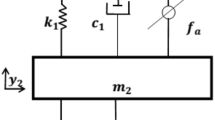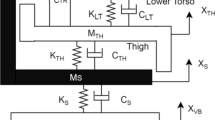Abstract
Vehicle active suspension systems (VASS) are designed to improve ride comfort and road handling capacity in the automotive industry. This paper investigates the problem of vibration suppression in full car model (FCM) with active suspension system (ASS) whose aim is to reduce the effect of the vibrations generated by road irregularities on the human body. The mathematical model is developed for seven degrees of freedom (DOF) FCM. The main objective is to control vibration of FCM for various road disturbances such as bump and random road disturbance using a fractional order sliding mode controller (FOSMC) and sliding mode controller (SMC). The effectiveness of the controllers are validated using MATLAB/Simulink software in terms of root mean square (RMS) values of body acceleration (BA), pitch acceleration (PA) and roll acceleration (RA). Further the power spectrum density (PSD) of BA is considered to show the human sensitivity range. The simulation results are indicated that FOSMC shows superior performance at adapting bump and random road disturbances compared to SMC and passive suspension system (PSS).




























Similar content being viewed by others
References
Young KD, Utkin VI, and Ozguner U (1996) A control engineer’s guide to sliding mode control. In: Variable structure systems, 1996. VSS’96. Proceedings, 1996 IEEE International Workshop on, p 1–14, IEEE
Chen B-C, Shiu Y-H, Hsieh F-C (2011) Sliding-mode control for semi-active suspension with actuator dynamics. Vehicle Syst Dyn 49(1–2):277–290
Chen H-Y, Huang S-J (2008) A new model-free adaptive sliding controller for active suspension system. Int J Syst Sci 39(1):57–69
Lian R-J (2013) Enhanced adaptive self-organizing fuzzy sliding-mode controller for active suspension systems. IEEE Trans Ind Electron 60(3):958–968
Yagiz N, Hacioglu Y, Taskin Y (2008) Fuzzy sliding-mode control of active suspensions. IEEE Trans Ind Electron 55(11):3883–3890
Li H, Yu J, Hilton C, Liu H (2013) Adaptive sliding-mode control for nonlinear active suspension vehicle systems using t-s fuzzy approach. IEEE Trans Ind Electron 60(8):3328–3338
Chamseddine A, Noura H (2008) Control and sensor fault tolerance of vehicle active suspension. IEEE Trans Control Syst Technol 16(3):416–433
Moradi M, Fekih A (2014) Adaptive pid-sliding-mode fault-tolerant control approach for vehicle suspension systems subject to actuator faults. IEEE Trans Vehicular Technol 63(3):1041–1054
Moradi M, Fekih A (2015) A stability guaranteed robust fault tolerant control design for vehicle suspension systems subject to actuator faults and disturbances. IEEE Trans Control Syst Technol 23(3):1164–1171
Imine H, Fridman L, Madani T (2015) Identification of vehicle parameters and estimation of vertical forces. Int J Syst Sci 46(16):2996–3009
Delavari H, Ghaderi R, Ranjbar A, Momani S (2010) Fuzzy fractional order sliding mode controller for nonlinear systems. Commun Nonlinear Sci Numer Simul 15(4):963–978
Ullah N, Shaoping W, Khattak MI, Shafi M (2015) Fractional order adaptive fuzzy sliding mode controller for a position servo system subjected to aerodynamic loading and nonlinearities. Aerosp Sci Technol 43:381–387
Luo J, Liu H (2014) Adaptive fractional fuzzy sliding mode control for multivariable nonlinear systems. Discrete Dyn Nat Soc 2014
Cheng C-P, Chao C-H, Li T-HS (2010) Design of observer-based fuzzy sliding-mode control for an active suspension system with full-car model. In: Systems Man and Cybernetics (SMC), 2010 IEEE International Conference on. p 1939–1944, IEEE
Rajendiran S, Lakshmi P, Rajkumar B (2016) Enhancing travel comfort of quarter car with driver model using fractional order terminal sliding mode controller with dual actuator. J electr Eng 16(4):203–214
Sneha K, Ponnusamy L, Kalaivani R (2015) Flc-based adaptive neuro-fuzzy inference system for enhancing the traveling comfort. In: Artificial intelligence and evolutionary algorithms in engineering systems. Springer, 61–70
Rajkumar B, Lakshmi P, Rajendiran S (2015) Vibration control of quarter car integrated seat suspension with driver model for different road profiles using fuzzy based sliding mode controller. In: Advanced computing (ICoAC), 2015 Seventh International Conference on. IEEE, p 1–6
Rajeswari K, Lakshmi P (2011) Vibration control of mechanical suspension system using labview. Int J Instrum Technol 1(1):60–71
Gáspár P, Szaszi I, Bokor J (2003) Design of robust controllers for active vehicle suspension using the mixed \(\mu\) synthesis. Veh Syst Dyn 40(4):193–228
Darus R, Sam YM (2009) Modeling and control active suspension system for a full car model. In: Signal processing & Its applications, 2009. CSPA 2009. 5th International Colloquium on, IEEE, p 13–18
Chul K, Paul R (2002) An accurate full car ride model using model reducing techniques. J Mech Des 124(4):697–705
Fang Z, Shu W, Du D, Xiang B, He Q, He K (2011) Semi-active suspension of a full-vehicle model based on double-loop control. Procedia Eng 16:428–437
Tavakoli-Kakhki M, Haeri M, Tavazoei MS (2010) Simple fractional order model structures and their applications in control system design. Eur J Control 16(6):680–694
Kuznetsov A, Mammadov M, Sultan I, Hajilarov E (2011) Optimization of improved suspension system with inerter device of the quarter-car model in vibration analysis. Arch Appl Mech 81(10):1427–1437
Slotine J-JE, Li W (1991) Applied nonlinear control, 199th edn. Prentice Hall, Englewood
Author information
Authors and Affiliations
Corresponding author
Additional information
Technical Editor: Kátia Lucchesi Cavalca Dedini.
Rights and permissions
About this article
Cite this article
Yuvapriya, T., Lakshmi, P. & Rajendiran, S. Vibration suppression in full car active suspension system using fractional order sliding mode controller. J Braz. Soc. Mech. Sci. Eng. 40, 217 (2018). https://doi.org/10.1007/s40430-018-1138-0
Received:
Accepted:
Published:
DOI: https://doi.org/10.1007/s40430-018-1138-0




